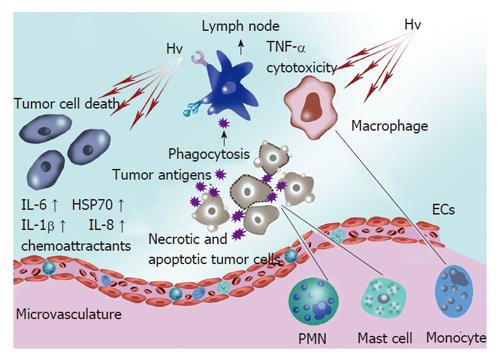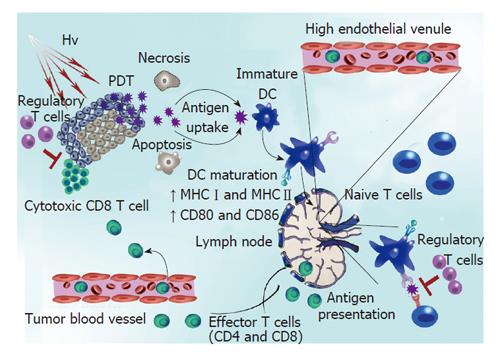Copyright
©2014 Baishideng Publishing Group Co.
Figure 1 Innate immune responses in anti-cancer photodynamic therapy.
Photodynamic therapy of tumors leads to the development of local inflammation mediated by the release of danger signals and cytokines. Various cells of the immune system infiltrate into the treated area. ECs: Endothelial cells; HSP70: Heat-shock protein; Hv: Light; PMNs: Polymorphonuclear neutrophils; TNF: Tumor necrosis factor; IL-6: Interleukin-6. Original figure based upon Ref. [115] and Ref. [116].
Figure 2 Stimulation of adaptive anti-tumor immunity by photodynamic therapy.
PDT-treated tumor cells release the antigens, which are phagocytosed by DCs and presented to naive T cells in the tumor draining lymph node. Activated effector T cells return in circulation and migrate to the tumor. Regulatory T cells seem to inhibit the immune responses after PDT. DCs: Dendritic cells; Hv: Light; MHCI: Major histocompatibility class I; PDT: Photodynamic therapy. Original figure based upon Ref. [115] and Ref. [116].
- Citation: Reginato E, Wolf P, Hamblin MR. Immune response after photodynamic therapy increases anti-cancer and anti-bacterial effects. World J Immunol 2014; 4(1): 1-11
- URL: https://www.wjgnet.com/2219-2824/full/v4/i1/1.htm
- DOI: https://dx.doi.org/10.5411/wji.v4.i1.1










